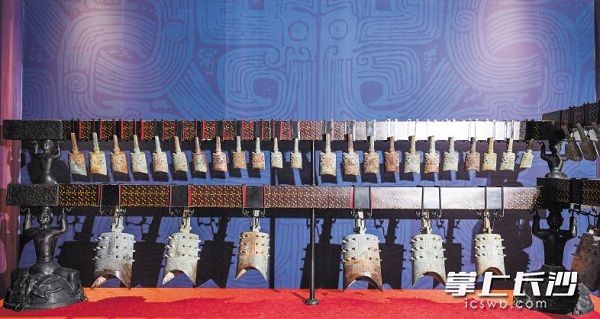7月26日至10月8日,随州出土周代青铜器特展将在长沙博物馆展出,带你感受三千年前随州发达的青铜文化和汉水流域高度发达的礼乐文明。
During July 26-October 8, 2017 in Changsha Museum, 280 pieces of bronze wares of Zhou Dynasty will be exhibited for free admission to present the ancient Chinese bronze culture and ritual civilization three thousand years ago.
此展将展出84套280件来自两周时期湖北随州出土曾、鄂等国的典型青铜文物,包括九鼎八簋、曾侯乙编钟“姊妹钟”和扉棱提梁卣等青铜瑰宝。
These exhibited bronze wares of the Zeng and E State of Zhou Dynasty were unearthed in Suizhou City, Hubei Province. The best of best exhibits include: sister Chime-bells of that unearthed from the Tomb of Marquis Yi of the Zeng State; Nine-Ding & Eight-Gui.
曾侯乙编钟“姊妹钟”:即为“擂鼓墩2号曾侯编钟”,是擂鼓墩二号墓中出土的另一套36件编钟,可以演奏古今中外大部分乐曲,音域广阔可与钢琴媲美,是目前国内除了曾侯乙编钟之外,可以对外展出的最大一套编钟。这套编钟也是中国的文化使者经常代表中国去世界各地巡展。
Sister Chime-bells of that unearthed from the Tomb of Marquis Yi of the Zeng State:
The chime-bells, composed of 36 suites can play most Chinese and western music in the ancient and modern times. Its wide tonal range is comparable with piano. Besides the chime-bells from the Tomb of Marquis Yi of the Zeng State, it is the largest chime-bells exhibited in China so far. The chime-bells has been also exhibited all over the world on behalf of the ancient Chinese cultural ambassador.
九鼎八簋:鼎用以供奉牲肉,簋用来供奉食粮,是当时最重要的祭器。青铜器在古代是身份与地位的象征,鼎与簋的搭配数量更是有严格的规定和特殊的意义。这次展出的九鼎八簋是诸侯墓出土。
Nine-Ding & Eight-Gui: Ding, an ancient cooking vessel, is used to consecrate sacrificed flesh; Gui, a round-mouthed food vessel with two or four loop handles, is used to consecrate food and grains. Since bronze wares symbolize status and position in the ancient Zhou Dynasty, the number of Ding & Gui has a special significance in strict rules. Nine-Ding & Eight-Gui exhibited were unearthed from tombs of marquis.
曾侯乙尊盘:盘上可以放冰和炭,使尊里的酒达到降温或加热的效果。供图/长沙博物馆
Wine Vessel from the Tomb of Marquis Yi of the Zeng State: Wine in the vessel can be cooled or heated by placing ice or carbon in the plate.
扉棱提梁卣(A typical wine vessel decorated in peculiar patterns of Zhou Dynasty)






Changsha Museum Exhibition: Rites and Music of Vassal States during 7.26-10.8 for Free Admission!
Editor:张焕勤
Source:english.rednet.cn
Updated:2017-07-25 12:01:30
Source:english.rednet.cn
Updated:2017-07-25 12:01:30
Special
Contact
Welcome to English Channel! Any suggestion, welcome.Tel:0731-82965627
lisl@rednet.cn
zhouqian@rednet.cn











